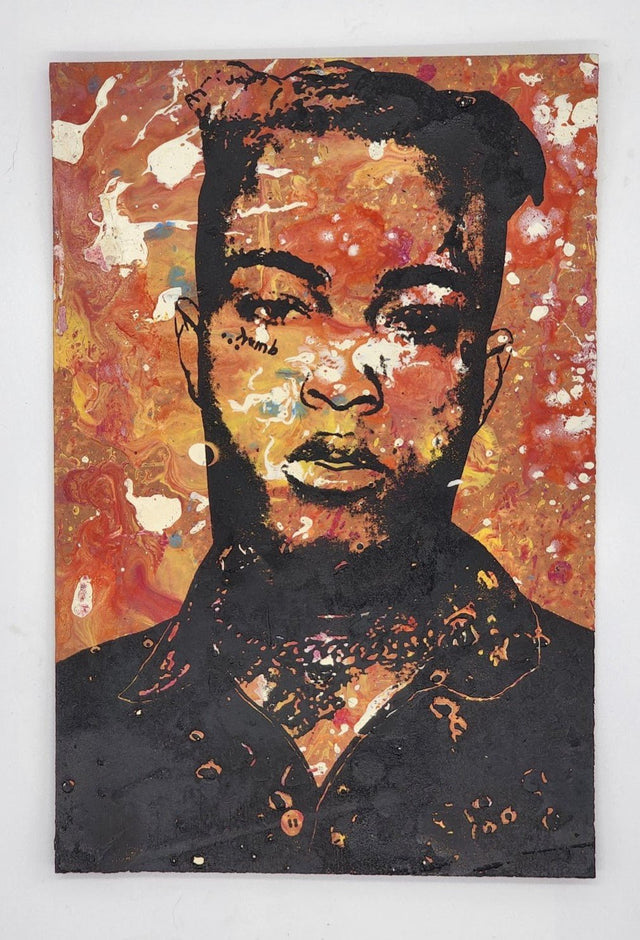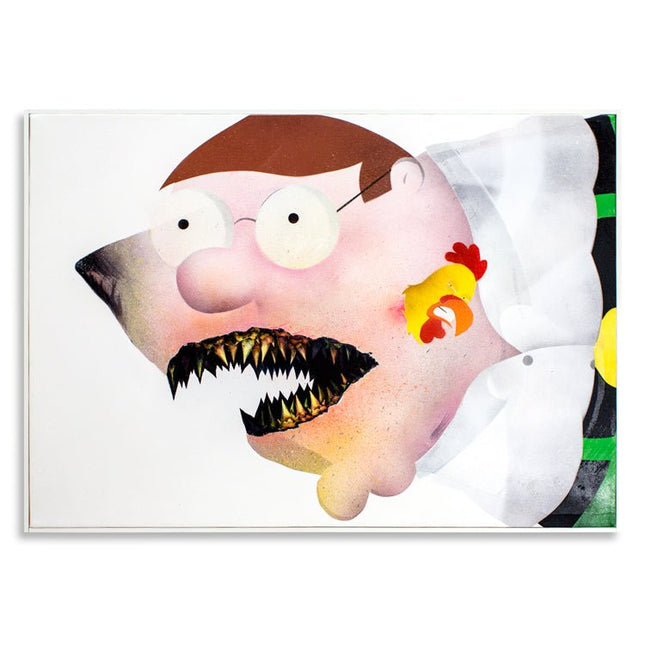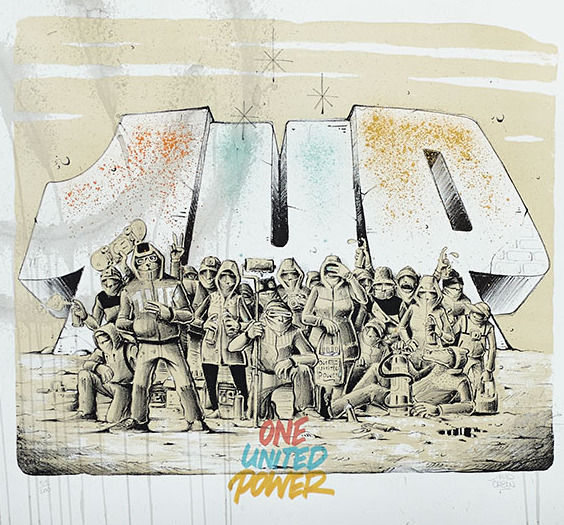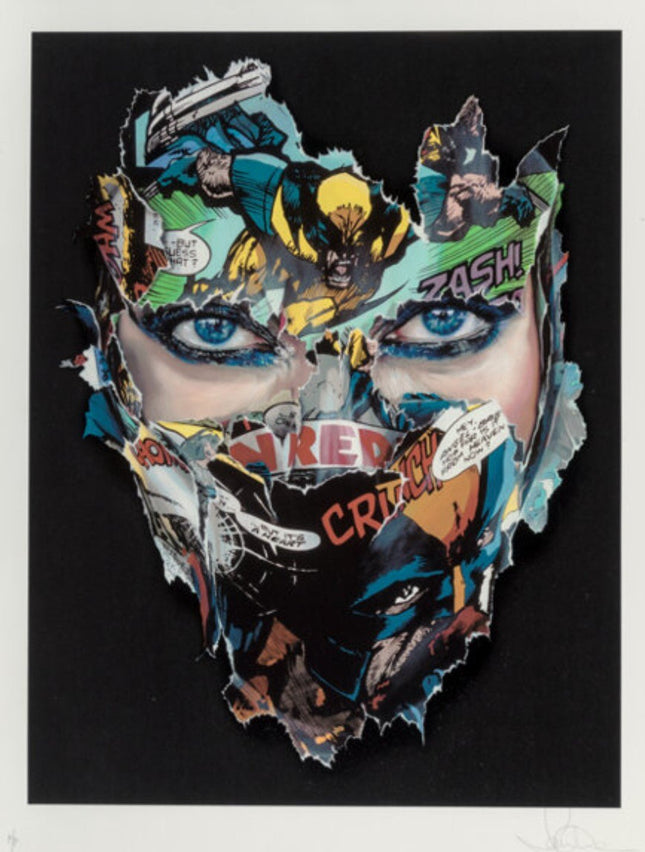
Man Male

Shark Toof Ceci N'est Pas Une Peter Griffin Original Spray Paint Mixed Media Painting by Shark Toof
Ceci N'est Pas Une Peter Griffin Original Painting Acrylic & Aerosol on Canvas by Shark Toof Graffiti Street Artist Modern Pop Art. 2014 Signed Orignal Spray Paint Mixed Media Painting Artwork Size 27x19 "This new body of work is a blend of my graffiti roots, where I developed my unique voice. At the same time, there's also an aspect of this work that is " not taking yourself too seriously, vandalizing your icons," Shark Toof said while preparing in Detroit. "I like Detroit because it is very do-it-yourself, and I am a very do-it-yourself artist, so it is a great fit for me."-Shark Toof The Artistic Dialect of Shark Toof: Subverting Pop Culture Icons Shark Toof's "Ceci N'est Pas Une Peter Griffin" is a compelling piece that showcases the artist's deft blend of graffiti roots with the playful irreverence of modern pop art. Created in 2014, this original painting embodies Shark Toof's unique voice, a voice he has cultivated through his deep connections with the street art movement. This artwork, measuring 27x19 inches, is a striking example of his mixed media mastery, incorporating acrylic and aerosol on canvas. In this piece, Shark Toof engages with the familiar iconography of pop culture, specifically the well-known character Peter Griffin from the animated sitcom "Family Guy." However, in true street art fashion, Shark Toof takes this familiar image and subverts it, adding layers of meaning and challenging the viewer's perceptions. The title, a nod to René Magritte's famous work, plays with the idea of representation and reality, encouraging viewers to question what they see. The painting's mixed media approach is characteristic of street pop art, which combines various techniques and materials to create dynamic visuals. Shark Toof's use of bold colors and exaggerated features captures the essence of graffiti art's impact while paying homage to pop art's stylized aesthetics. His work does not shy away from humor or satire; instead, it embraces these elements to deliver a more profound commentary on the nature of celebrity, fandom, and the art world itself. In the context of street pop art and graffiti artwork, Shark Toof stands out as an artist who embodies the DIY spirit of the genre. His affinity for cities like Detroit, with their rich industrial pasts and vibrant street art scenes, speaks to his commitment to the grassroots nature of his craft. Shark Toof's work, including "Ceci N'est Pas Une Peter Griffin," is a visual feast and a testament to the transformative power of street art in the modern era. Through his art, Shark Toof continues to push the boundaries of street pop art, showcasing its potential to be both playful and piercingly insightful. His ability to navigate the intersection of street art and fine art while maintaining a sense of authenticity and approachability ensures that his work resonates with a broad spectrum of art enthusiasts and collectors alike.
$2,833.00

1UP Crew- One United Power 20 Years 1UP Lithograph HPM Print by 1UP Crew- One United Power
20 Years 1UP Lithograph HPM Embellished Print by 1UP Crew- One United Power Hand-Pulled Print on 270gsm BFK Rives Fine Art Paper Limited Edition Graffiti Street Pop Artwork. 2023 Signed & Numbered HPM Hand-Embellished Limited Edition of 200 Artwork Size 27x24 The Artistic Valor of 1UP Crew in Graffiti Street Pop Art In the domain of Graffiti Street Pop Art, the 1UP Crew — One United Power — has been a formidable presence, synonymous with the collective spirit and the energetic assertion of street culture. Their "20 Years 1UP Lithograph HPM Embellished Print" encapsulates two decades of the collective's evolution and influence within the street art community. This hand-pulled print on the exquisite 270gsm BFK Rives Fine Art Paper represents a legacy crafted through unity and the unapologetic embrace of public space as a canvas for creative expression. Limited to a series of 200, each lithograph carries a unique signature and numbering that authenticates its place in the limited edition series. The size of the artwork, 27x24 inches, allows it to command attention, mirroring the imposing nature of their street murals. Technique and Exclusivity in Limited Edition Prints The technique employed in creating these prints, particularly the hand-embellishment or HPM (Hand-Painted Multiples), underscores the personalized touch that 1UP Crew infuses into each piece. Despite the reproducibility implied in printmaking, hand-embellishments ensure that no two prints are entirely alike, granting each piece a degree of originality highly prized in both the art world and the more democratic arena of street art. This fusion of mass production with individual customization aligns with the democratic ideals of street art while also upholding the exclusivity valued by fine art collectors. Furthermore, the choice of BFK Rives Fine Art Paper for the prints is a nod to the quality and durability that collectors seek. Known for its texture and resistance to aging, this paper is a favorite among printmakers and artists who wish to see their work preserved for posterity. When street art, often temporary and vulnerable to the elements, is transposed onto such a medium, it gains a form of permanence that counteracts the transient nature of its original form. Cultural Impact of the 1UP Crew The cultural impact of the 1UP Crew extends far beyond the physical confines of their artworks. Originating from Berlin, Germany, the collective's members maintain anonymity, allowing their work to stand as a collective statement rather than as the vision of individual artists. This anonymity also emphasizes the 'one united power' philosophy they embody, a principle that resonates deeply within the street art community. This unity and shared identity allow them to operate not just as a crew but as a movement, leaving a mark on the urban landscapes across continents. The artwork '20 Years 1UP Lithograph HPM Embellished Print' is both a retrospective and a testament to the crew's staying power. The visual narrative within the print, often featuring the iconic large-scale block-letter tags and the portrayal of masked figures, reveals stories of camaraderie, risk, and the subversive joy of graffiti. The figures, often depicted in motion or the act of creation, symbolize the energy and defiance that are hallmarks of the crew's style. This particular lithograph, with its celebratory text 'One United Power,' encapsulates the ethos of solidarity that 1UP has fostered. It is a visual manifesto of their journey from the fringes of the art scene to becoming a globally recognized collective. Their work has transcended the initial territorial markers of graffiti to become significant contributions to the discourse of Street Pop Art, with every tagged wall, train, or canvas serving as a conduit for public engagement and dialogue. The '20 Years 1UP Lithograph HPM Embellished Print' by 1UP Crew is a remarkable synthesis of graffiti's ethos with pop art's sensibilities. As collectors and enthusiasts secure their numbered prints, they hold a fragment of the raw, unfettered spirit that drives the street art movement. Each piece is a testament to the enduring nature of collective identity and the powerful voice that arises when individuals come together to create, challenge, and celebrate. This artwork is not just a collectible; it is a piece of the cultural zeitgeist, symbolic of the transformative power of street pop art and the resonance of communal creation.
$650.00

Sandra Chevrier La Cage Et Le Cœur De La Bête PP Silkscreen Print by Sandra Chevrier
The Cage And The Heart Of The Beast PP Printers Proof Silkscreen Print on Somerset Fine Art Paper by Artist Sandra Chevrier Limited Artwork. PP Printers Proof 2019 Signed & PP Marked Artwork Size 27x35.5. Sandra Chevrier (b. 1983) La Cage Et Le Coeur De La Bête, 2019 Screenprint in colors on Somerset paper 35-1/2 x 27 inches (90.2 x 68.6 cm) (sheet) PP Signed and numbered in pencil along lower edge Published by Graffiti Prints, United Kingdom Emotive Power in Chevrier's Art Sandra Chevrier's "La Cage Et Le Coeur De La Bête" (The Cage And The Heart Of The Beast) is a compelling silkscreen print that weaves together the visual intensity of street art with the emotional depth of pop art. This Printer's Proof (PP) edition, produced in 2019, is a signature work that underscores Chevrier's reputation as a formidable talent in contemporary art. The piece, published by Graffiti Prints in the United Kingdom, represents a confluence of techniques and themes that resonate deeply within the art community. "La Cage Et Le Coeur De La Bête" visually explores identity, constraint, and liberation. Chevrier's work often features the motif of a woman's face obscured by comic book imagery, a representation of the societal 'cages' that can define and restrain. In this piece, the vivid colors and dynamic, funny book scenes that overlay the subject's face serve as both a mask and a revelation of the inner turmoil and strength within the female subject. The print, measuring 35-1/2 x 27 inches, is a testament to the artist's detailed and intricate approach to silkscreen printing, a medium that allows for the sharp articulation of complex images. The choice of Somerset paper for the print indicates Chevrier's commitment to quality; it's a type of paper renowned for its ability to hold ink and produce rich, vivid images. Chevrier's Commentary on Femininity and Strength Chevrier's "La Cage Et Le Coeur De La Bête" is imbued with a narrative of femininity and strength. It challenges the viewer to contemplate the juxtaposition of vulnerability and power, the seen and unseen, and the personal versus the societal. The inclusion of superhero imagery superimposed on the woman's face brings a dialogue of the fantastical into the realm of the every day, prompting reflection on the heroic qualities found in the personal battles we face. This piece, marked as a Printer's Proof, highlights its unique status in the printmaking process, often reserved for the artist's and printer's use before the final edition is run. The PP designation enhances the artwork's collectibility, signifying it as a rare piece of Chevrier's work. Street Pop Art and Graffiti Influence In the realm of street pop art and graffiti artwork, Chevrier's print stands as a vibrant example of how fine art's intimacy can intersect with street art's public-facing boldness. Her work captures the ethos of street art's accessibility and its capacity for profound emotional resonance, all while maintaining the collectible aspect of limited-edition fine art prints. Sandra Chevrier's "La Cage Et Le Coeur De La Bête" is more than just a silkscreen print; it's a narrative piece that engages with empowerment, constraint, and identity themes. It reflects the artist's distinct place in the landscape of street pop art and graffiti artwork, where the lines between personal expression and broader cultural commentary are seamlessly blended. Through her art, Chevrier invites us to recognize and reflect on the cages that confine us and the potential within each of us to find our own heart of the beast.
$4,165.00




